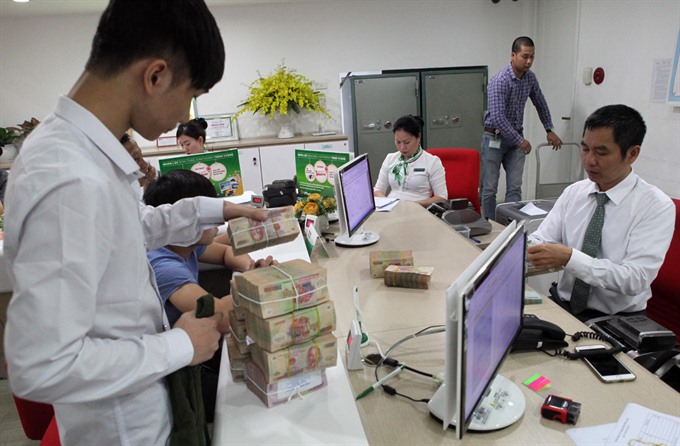 Economy
Economy

The State Bank of Việt Nam (SBV) is drafting a law on supporting credit institutions to restructure and resolve bad debt in an effort to quicken the process.
 |
| A customer and staff at VP Bank’s head office in Hà Nội. — VNA Photo Trần Việt |
HÀ NỘI — The State Bank of Việt Nam (SBV) is drafting a law on supporting credit institutions to restructure and resolve bad debt in an effort to quicken the process.
The incomplete legal framework for handling poorly-performing banks and bad debts is hindering the restructuring of credit institutions, according to SBV.
The central bank in a note pointed out that it currently does not have adequate jurisdiction to handle weak banks, and there is a shortage of mechanisms and resources for handling bad debts and mortgaged assets, which increase risks to the system and the whole economy.
The first draft version of the law, which SBV recently published for comments, provides mechanisms for the first time for weak banks to file for bankruptcy. The idea of allowing weak banks to go bust was not new but was included in a legal document for the first time.
Allowing bankruptcy was necessary when the restructuring of the banking system must be hastened and improved in term of quality, according to Bảo Việt Securities.
Statistics show that as of the end of 2016, bad debt ratio was controlled at below 3 per cent, but the central bank warned that it could amount to 8.86 per cent if bad debts managed by the Việt Nam Asset Management Company (VAMC) and loans which could potentially turn into non-performing were included.
The safety of the credit institution system in Việt Nam remains low compared to other countries in the region, while the burden of supplying capital for the economy was increasingly heavy, making the system vulnerable to shocks, the central bank said.
The ratio of credit to GDP increased in 2012-15 from 95.2 per cent to 111.1 per cent, high compared to Indonesia (36.5 per cent), the Phillippines (39.1 per cent), Brazil (67.1 per cent) and India (51.6 per cent).
“If the legal framework is not improved, it will be impossible to promote banking capital, which will affect GDP growth,” the central bank said in the note. “It is necessary to have a separate law to enhance the restructuring in the next five years towards efficiency.”
Let weak banks fall?
Lawyer Bùi Quang Tín from the Banking University of HCM City said bank bankruptcy is new to Việt Nam and the process would need a carefully-prepared roadmap.
Last year, Deputy Prime Minister Vương Đình Huệ said that Việt Nam should bravely pilot allowing a bank to go bankrupt, but the bankruptcy must ensure rights of depositors and not cause a domino effect.
According to Nguyễn Văn Hưng, the SBV’s Deputy Chief Inspector, 2017 would be the year to handle weak banks thoroughly in order to resolve cross ownership among credit institutions.
SBV planned to handle five weak banks this year, including three banks bought at zero đồng - Việt Nam Construction Bank, OceanBank and GPBank.
The central bank would also consider letting some poorly-performing financial companies and credit funds go bankrupt, as a warning for the whole system.
Six-year credit high
Banking credit grew 2.81 per cent in the first quarter of 2017 over the same period last year, a six-year high, according to the General Statistics Office (GSO).
Credit growth in Q1 was higher than deposit growth of 2.43 per cent, reflecting the improved capital absorption capacity of businesses.
Deposit rates were stable at 4.5-5.4 per cent per year for deposits of 1-6 months, 5.4-6.5 per cent for 6-12 months and 6.4-7.2 per cent for 12 months and up.
Lending rates were at 6-7 per cent for prioritised sectors and 6.8-9 per cent for short-term loans and 9.3-11 per cent for medium and long-term loans. — VNS




